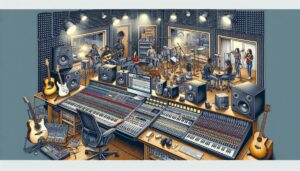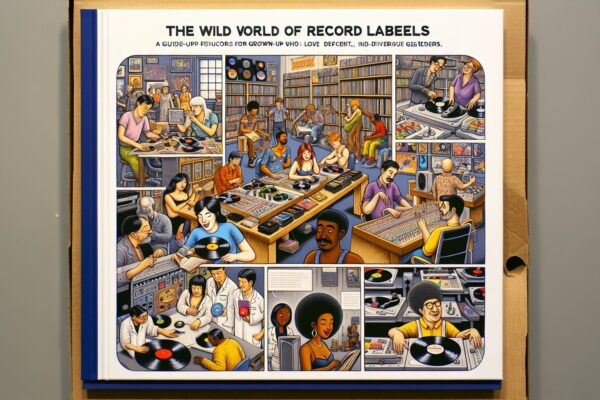Music has the power to move us, heal our souls, and transport us to new worlds. Whether you’re a professional musician or an aspiring artist, the world of music production offers endless possibilities for creativity and self-expression. From the early days of tape recorders to today’s digital wonders, let’s dive into the art of music production, exploring instruments and techniques that can take your musical journey to new heights.
Introduction: A Symphony of Sound
Music production is the process of creating and shaping sound by combining different elements, instruments, and techniques. It’s a dynamic and ever-evolving world, where artists can push the boundaries of their imagination and make their passion come alive. To embark upon this creative adventure, let’s start by exploring some essential musical instruments.
The Melodies of Musical Instruments
Musical instruments form the backbone of any composition. They provide melodies, harmonies, and rhythms that intertwine to create captivating music. From classical orchestral instruments like the piano and violin to modern electronic instruments, here are a few instruments worth exploring:
- Piano: The piano is a versatile instrument capable of producing rich harmonies and delicate melodies. With its vast range, it can evoke a wide range of emotions, from soothing ballads to thunderous symphonies.
- Guitar: The guitar is the cornerstone of many popular music genres. Whether it’s the warmth of an acoustic guitar strumming chords or the electrifying riffs from an electric guitar, its versatility makes it a must-have in any artist’s arsenal.
- Drums: The driving force behind rhythm, drums bring energy and groove to compositions. From acoustic drum kits to virtual drum machines, they can be tailored to fit any musical style, from rock to hip hop instrumentals.
- Violin: The violin’s soulful melodies and emotional resonance have made it a beloved instrument across various genres. Whether it’s classical music, folk tunes, or even experimental electronic music, the violin can add a touch of elegance and grandeur to any piece.
Unleashing the Power of Music Production Tools
Once you’ve chosen your instruments, it’s time to delve into the world of music production tools that can transform your musical ideas into reality. Here are a few essential tools to get you started:
- Digital Audio Workstations (DAWs): DAWs are the backbone of modern music production. They provide a virtual recording studio environment where you can record, edit, and mix your music. Popular DAWs include Ableton Live, Logic Pro, and FL Studio.
- Sequencers: Sequencers allow you to create and arrange musical patterns and sequences. They provide a platform for composing melodies and rhythms, enabling you to experiment with different combinations and structures.
- Sampling Tools: Sampling involves taking snippets of audio from various sources and manipulating them to create unique sounds. With sampling tools and techniques, you can add depth and flavor to your music by incorporating real-world sounds or other pre-existing recordings.
- Virtual Instruments: Virtual instruments replicate the sounds of real instruments, opening up a world of possibilities. From grand pianos to soaring string sections or electronic synthesizers, these software instruments allow you to create music without needing physical instruments.
Crafting Beats and Hip Hop Instrumentals
In recent years, beat making and hip hop instrumentals have gained immense popularity. This genre places significant emphasis on rhythm and groove, creating infectious beats that make heads nod and bodies move. Here are a few techniques to consider when crafting beats:
- Drum Programming: The kick, snare, hi-hat, and other percussive elements form the backbone of a beat. Experiment with different drum patterns and rhythms to find the perfect groove for your track.
- Sampling: Sampling plays a crucial role in hip hop instrumentals. It involves taking snippets of existing recordings and creatively manipulating them to create unique sounds. Whether it’s chopping up drum breaks or adding vocal snippets, sampling can add an extra layer of depth and personality to your beats.
- Effects and Production Techniques: Utilize various effects, such as reverb, delay, and compression, to shape your beats and add sonic character. Experiment with mixing techniques to create a dynamic and balanced final product.
Conclusion: Be the Composer of Your Musical Journey
As musicians and artists, we are constantly evolving and exploring new ways to express our creativity. The art of music production offers a vast playground for innovation and self-discovery. Whether you’re a classical pianist, a rock guitarist, or an electronic music producer, the combination of instruments, tools, and techniques can help you unlock new realms of sonic possibility.
So, dive into the world of music production, unleash your imagination, and become the composer of your musical journey. With the right instruments, tools, and techniques, you can create music that resonates with your audience, transcends boundaries, and leaves a lasting impact on the world. Let your sonic masterpiece take flight, and may your musical endeavors be filled with endless inspiration.



